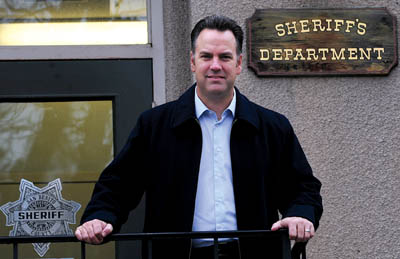He nearly escaped: a bandito’s last hurrah
By 1873, even though he hadn’t yet been caught, the final
episode was drawing near for the infamous renegade, Tiburcio
Vasquez, and his band of banditos. The year had stamped a hallmark
in the number and intensity of vicious crimes the men perpetrated
on innocent citizens in the San Joaquin, Santa Clara and San Benito
areas.
He nearly escaped: a bandito’s last hurrah
By 1873, even though he hadn’t yet been caught, the final episode was drawing near for the infamous renegade, Tiburcio Vasquez, and his band of banditos. The year had stamped a hallmark in the number and intensity of vicious crimes the men perpetrated on innocent citizens in the San Joaquin, Santa Clara and San Benito areas.
Probably no single account of the era will ever be totally accurate. Witnesses and those close to them, even folks who never met the band of highway robbers, all told different versions of each crime. The versions were at best a mix of fact, fiction, and wishful thinking.
But one thing seemed evident: by 1873, the light at the end of the tunnel was fast coming into view for Tiburcio Vasquez. He wasn’t in just a peck of trouble. At last he’d pushed the envelope too far, and the law, seriously and earnestly, was closing in.
On February 25, 1873, an outrageous robbery had been committed at Firebaugh’s Ferry. George Hoffman, a postmaster and Wells Fargo agent who also kept a hotel and store at the settlement, was just cleaning up the kitchen following dinner. As seven boarders were relaxing in the parlor, five men burst in, pistols drawn. Quickly, the lodgers were tied up and forced to lie on the floor. As Hoffman entered the scene, the men forced him to open the safe. They grabbed the contents, amounting to $350. Just at that moment, the Visalia stage arrived from Gilroy. As passengers alighted, they too were tied up and left lying on the ground. The stage driver, Dennis Conroy, recognized the band as a group that had held up his stage a year before at Soap Lake. Following that robbery, after one of the holdup men was captured, it was Conroy’s court testimony that had put the criminal away for 20 years. Conroy lay very still that night at Firebaugh’s Ferry, on the ground outside George Hoffman’s place, praying the men wouldn’t recognize him.
From then on, thanks to Conroy’s description, law officers positively recognized the robbers as Tiburcio Vasquez’s men. The heat of chase was intense. For a time, Vasquez’s group roamed the San Benito area, terrorizing residents and conducting small holdups at shops and bars.
Then, on July 28, 1873, they hit another big strike, this time at the 21-Mile House, south of San Jose. That night, six horsemen barged into the tavern, guns drawn, threatening the manager, Mr. Finley, plus two farm hands and a traveling sewing machine salesman. After relieving the customers of watches and forcing the manager to empty the till of $155, the men lingered long enough to toss back a couple of whiskey shots before mounting their steeds and galloping off into the darkness. It didn’t take long for authorities to connect the men with the Firebaugh’s Ferry holdup.
By the end of the same month, they were back in their usual haunt, the New Idria vicinity. At 5 p.m. on August 26, 1873 they hit Snyder’s Store at Paicines. That evening, a triple murder occurred which not only rocked the entire state for its cold-blooded viciousness, but sealed Vasquez’s fate for good. Immediately, Sheriff Wasson of Monterey County and Sheriff Adams of Santa Clara County sent out a posse. Early leads were cold. The robbers’ trail led deeper into San Benito County, but frightened residents misled officers with rumors that had the gang roaming everywhere from the San Joaquin Valley to Los Angeles. Even more exaggerated rumors claimed the murderous Vasquez bunch had fled to Arizona, or even Mexico. Others claimed the renegades had been lurking nearby, perhaps lying low at a stronghold in the Gabilans. In the meantime, Mr. Snyder at Paicines lived in fear for his life, worried that the gang, hearing he was still alive, would return and gun him down. Snyder, after all, had recognized them when they walked in, since they had been his frequent customers.
By the middle of September, two Vasquez members were finally apprehended. Guadalupe Auleveras was suspected in the 21-Mile House holdup and as an accessory after the fact in the Paicines crime. His cohort, Teodoro Morano, was known to be present at one of the three Paicines murders. While Sheriffs Wasson and Adams headed out to round up another suspect, said to be headed for the mines at New Idria, the two captured men were booked first in Gilroy, later taken to the county jail at Salinas.
An earlier gang member, Adon Leiva, had turned himself in and was said to be “crowing” to authorities. He claimed the recent capture, Morano, had killed one of the Paicines victims, a sheepherder variously described as a Frenchman, a Spaniard and a Portuguese. He also said the still at-large Vasquez had personally killed the other two at Paicines, the hotelkeeper, Leland Davison, and Gilroyan, George Redford. Leivas’s confession was backed up when Auleveras was later found in possession of stolen goods from Snyder’s Store. Leiva’s motive for squealing to authorities was hardly noble; having once found his wife in bed being seduced by Vasquez, he’d just been waiting for the right moment to wreak revenge on his former boss.
The Paicines massacre wasn’t the end of Vasquez’s crime spree, but the dragnet was drawing tighter. Thanks to Leiva’s tips and leads from crime witnesses, the desperado was finally located by Sheriff William Rowland of Los Angeles. Nine months after the Snyder’s Store murders, the sheriff traced him, and the remainder of his band to a cabin near the Cahuenga Pass.
After a brief standoff, on May 15, 1874, the feared renegade was at last captured and transported to the county jail at San Jose. Following his trial, Tiburcio Vasquez was hanged in Santa Clara on March 19, 1875, spelling a short finale to a long and bloodthirsty life.







